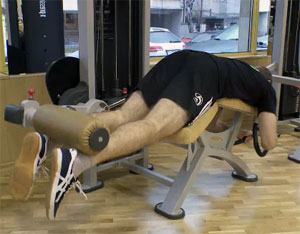 Femoral machine bending is a simple, isolating exercise for the back thigh muscles. It is suitable for beginners, intermediate and advanced fitness and bodybuilding enthusiasts. There are many different machines that offer variety in the performance of hip flexion, but the motor chain, ie. the working muscle complex remains the same.
Femoral machine bending is a simple, isolating exercise for the back thigh muscles. It is suitable for beginners, intermediate and advanced fitness and bodybuilding enthusiasts. There are many different machines that offer variety in the performance of hip flexion, but the motor chain, ie. the working muscle complex remains the same.
Contraindications
Properly performed, the exercise does not pose a serious risk to the health of the musculoskeletal system. Certain execution errors can lead to muscle strains and low back pain. Calf cramps are a common problem in its implementation. This is corrected by including 1-2 warm-up sets of any calf exercise.
Participating muscles
Dynamists
- Posterior thigh muscles (Biceps femoris, Semitendinosus, Semimbranosus)
Synergists
- Calves (Gastrocnemius)
- Knee flexors (Popileteus)
- Sewing muscles (Sartorius)
- Gracialis
Extras and dynamic stabilizers
- Tibialis anterior
- Quadriceps, middle heads (Rectus femoris)
- Gluteus (Gluteus maximus) in a variant of unilateral execution of the facial semi-leg at the knee support
- Straight abdominal muscle
- Oblique abdominal muscles (Obeliques) in the variant of unilateral execution of the facial semi-leg at the knee support
- Long spinal muscles (Erector spinae) in a variant of unilateral execution of the facial semi-leg at the knee support
- Adductors with an accent with the legs together.
Machines according to body position
- From the front half-legged with knee support – allows the performance of unilateral folds.
- From a supine position – a common machine configuration. Allows all types of executions in terms of consistency. Removes the stabilizing role of the gluteus, increases the stabilizing role of the abdominal muscles.
- From a seat – a popular option. Most often it relieves the load on the waist, even with poor stabilization. Suitable for beginners. Allows execution in all sequence variants.
- From a standing position – a rare machine. Allows only unilateral folds. Gives good conditions for accentuation. Stabilization is difficult.
According to the position “knees-ankles-feet”
- Gathered knees, gathered ankles and touched feet – even distribution of the folding role of all dynamite muscles and muscle heads.
- Spaced knees, spaced ankles, parallel feet evenly distributed between the folds. Good option for checking left-right or double-sided internal / external power imbalance. At the peak, the stronger muscle group dominates and bends the knees and ankles inward or outward.
- Spaced knees, spaced ankles, outwardly open feet – In practice, there is a slight rotation of the knees outward. The emphasis is on the outer part of the posterior thigh muscles (Biceps femoris). The tightening of the gluteal muscles improves the control of the accent.
- Knees the width of the pelvis, ankles inward from the knees, feet closed (toes inwards) – there is a slight rotation in the knees inward to the axis of the ground. The emphasis is on the internal flexor muscles (Semimembranosus, Semitendinosus).
According to the sequence of execution
- Unilateral – unilateral extension (with only one leg) allows you to concentrate entirely on the working muscle. This option is used to shape the folds of the thighs.
- Bilateral – bilateral performance (with both feet at the same time) is the most popular and most effective. You can use it for both table and styling – it depends on your workload.
- Consecutively – in the sequential unfolding you perform one repetition with one leg, then one repetition with the other leg and so on – until the end of the series. This option allows longer series, reduces nervous fatigue and increases the threshold before going into oxygen deficiency mode. It is used to increase the total raised volume and for more strength and aerobic endurance. In order to isolate and compensate for asymmetrical development in the thighs – left-right or in case of force imbalance between the inner and outer sector in the thighs.
Execution
- Adjust the appliance to your height and especially to the length of your legs.
- Choose a workload.
- Stand comfortably on the appliance and grasp the handles for better support.
- Choose a position for knees, ankles and feet.
- Bend your legs at the knees until your knees are just past the right angle.
- Relax in a controlled manner, stopping shortly before fully unfolding.
- Repeat.
Recommendations
- If you perform the movement with an emphasis on the load, shorten the working amplitude so as not to overload the knee flexors.
- If you get cramps in the calves during peak flexion – stop the series, crush. Do 30-50 finger raises and continue.
The hip folds can be used for both mass and relief of the hip folds. You need to include them in your training, regardless of your level of development. Place them after the quadriceps exercises (squats, leg presses, hacken squats, thigh extensions).
